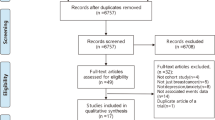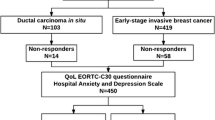Abstract
Depression and anxiety are the core disorders causing emotional distress in patients (pts) with metastatic breast cancer. The aim of our study was to screen metastatic breast cancer outpatients for anxiety and depression, and to investigate the influence of age, Karnofsky Performance Status (KPS), cancer activity, and inflammation as represented by IL-6 levels on these two mood disorders. Pts treated with chemotherapy for metastatic breast cancer (n = 70) were assessed using the Hospital Anxiety and Depression Scale (HADS) for symptoms (scores 0–21) and caseness (score ≥11) of clinical depression and anxiety. Blood samples for IL-6 concentrations were collected at 10:00 a.m. A total of 22 (31.4 %) pts were diagnosed with caseness of clinical depression and 23 (32.9 %) pts with clinical anxiety, while 12 pts were diagnosed positive for both mood disorders. Depression and anxiety were positively but moderately correlated (Spearman’s r 2 = 0.24, p < 0.001). IL-6 was significantly correlated with symptoms of depression (r 2 = 0.42, p < 0.001) and to a lesser extent to symptoms of anxiety (r 2 = 0.16, p = 0.001). In addition, IL-6 was positively associated with tumor progression (p < 0.001). Multiple linear regression analysis showed that tumor progression (standardized b = 0.226, p = 0.047), symptoms of anxiety (b = 0.292, p = 0.016), and IL-6 (b = 0.314, p = 0.007) were independently associated with clinical depression, whereas anxiety was linked to tumor progression (b = 0.238, p = 0.030), symptoms of depression (b = 0.407, p < 0.001) and age (b = −0.381, p < 0.001), but not to IL-6 (b = 0.168, p = 0.134). Even though a positive correlation between depression and anxiety exists, clinical parameters like age, cancer activity, KPS, and IL-6 do influence depression and anxiety differently. Unlike clinical depression, anxiety is not associated with increased IL-6 levels, however, shows a reciprocal correlation with age.



Similar content being viewed by others
Abbreviations
- DSM-IV:
-
Diagnostic and statistical manual of mental disorders
- HADS:
-
Hospital Anxiety and Depression Scale
- IL-6:
-
Interleukin 6
- KPS:
-
Karnofsky performance status
- MMSE:
-
Mini-mental state examination
- PD:
-
Progressive disease
- PR:
-
Partial remission
- Pts:
-
Patients
- SD:
-
Stable disease
- WHO:
-
World Health Organization
References
Jemal A, Bray F, Center MM et al (2011) Global cancer statistics. CA Cancer J Clin 61(2):69–90
Costa D, Mogos I, Toma T (1985) Efficacy and safety of mianserin in the treatment of depression of women with cancer. Acta Psychiatr Scand Suppl 320:85–92
Stoudemire A, Thompson TL (1983) Medication noncompliance: systematic approaches to evaluation and intervention. Gen Hosp Psychiatr 5(4):233–239
Koenig HG, Shelp F, Goli V, Cohen HJ, Blazer DG (1989) Survival and health care utilization in elderly medical inpatients with major depression. J Am Geriatr Soc 37(7):599–606
Fisch M (2004) Treatment of depression in cancer. J Natl Cancer Inst Monogr 32:105–111
Ashbury FD, Findlay H, Reynolds B, McKerracher K (1998) A Canadian survey of cancer patients’ experiences: are their needs being met? J Pain Symptom Manag 16(5):298–306
Van’t Spijker A, Trijsburg RW, Duivenvoorden HJ (1997) Psychological sequelae of cancer diagnosis: a meta-analytical review of 58 studies after 1980. Psychosom Med 59(3):280–293
Rabe-Jablonska J, Bienkiewicz W (1994) Anxiety disorders in the fourth edition of the classification of mental disorders prepared by the American Psychiatric Association: diagnostic and statistical manual of mental disorders (DMS-IV––options book. Psychiatr Pol 28(2):255–268
Katon W, Sullivan MD (1990) Depression and chronic medical illness. J Clin Psychiatr 51(Suppl):3–11
Aapro M, Cull A (1999) Depression in breast cancer patients: the need for treatment. Ann Oncol 10(6):627–636
Jenkins R, Bebbington P, Brugha T et al (2003) British Psychiatric Morbidity Survey. Int Rev Psychiatr 15(1–2):14–18
Cassileth BR, Lusk EJ, Hutter R, Strouse TB, Brown LL (1984) Concordance of depression and anxiety in patients with cancer. Psychol Rep 54(2):588–590
Danzer K (1993) The new education for the care of the well and the ill may start. Osterr Krankenpfl 46(2):8–10
Dentino AN, Pieper CF, Rao MK et al (1999) Association of interleukin-6 and other biologic variables with depression in older people living in the community. J Am Geriatr Soc 47(1):6–11
Mastorakos G, Chrousos GP, Weber JS (1993) Recombinant interleukin-6 activates the hypothalamic–pituitary–adrenal axis in humans. J Clin Endocrinol Metab 77(6):1690–1694
Sluzewska A, Rybakowski J, Bosmans E et al (1996) Indicators of immune activation in major depression. Psychiatr Res 64(3):161–167
Musselman DL, Miller AH, Porter MR et al (2001) Higher than normal plasma interleukin-6 concentrations in cancer patients with depression: preliminary findings. Am J Psychiatr 158(8):1252–1257
Karnofsky DA, Burchenal JH (1950) Present status of clinical cancer chemotherapy. Am J Med 8(6):767–788
Eisenhauer EA, Therasse P, Bogaerts J, Schwartz LH et al (2009) New response evaluation criteria in solid tumours: revised RECIST guideline (version 1.1). Eur J Cancer 45:228–247
Iconomou G, Mega V, Koutras A, Iconomou AV, Kalofonos HP (2004) Prospective assessment of emotional distress, cognitive function, and quality of life in patients with cancer treated with chemotherapy. Cancer 101(2):404–411
Herrmann C (1997) International experiences with the hospital anxiety and depression scale––a review of validation data and clinical results. J Psychosom Res 42(1):17–41
Zigmond AS, Snaith RP (1983) The hospital anxiety and depression scale. Acta Psychiatr Scand 67(6):361–370
Moorey S, Greer S, Watson M et al (1991) The factor structure and factor stability of the hospital anxiety and depression scale in patients with cancer. Br J Psychiatr 158:255–259
American Psychiatric Association (1994) Diagnostic and statistical manual of mental disorders. American Psychiatric Association, Washington
Flower L, Humphries SE, Mohamed-Ali V et al (2000) Effects of sample handling on the stability of interleukin-6, tumor necrosis factor-a and leptin. Cytokine 12:1712–1716
Noyes R, Kathol RG, Debelius-Enemark P et al (1990) Distress associated with cancer as measured by illness distress scale. Psychosomatics 31:321–330
Massie MJ et al (2004) Prevalence of depression in patients with cancer. J Natl Cancer Inst Monogr 32:57–71
Pierce BL, Ballard-Barbash R, Berstein L et al (2009) Elevated biomarkers of inflammation are associated with reduced survival among breast cancer patients. J Clin Oncol 27:3437–3444
Salgado R, Junius S, Benoy I et al (2003) Circulating interleukin-6 predicts survival in patients with metastatic breast cancer. Int J Cancer 103:642–646
Zhang GJ, Adachi I et al (1999) Serum interleukin-6 levels correlate to tumor progression and prognosis in metastatic breast carcinoma. Anticancer Res 19:1427–1432
Mantovani A, Allavena P, Sica A et al (2008) Cancer-related inflammation. Nature 454:436–444
Chiang AC, Massague J (2008) Molecular basis of metastasis. N Engl J Med 359:2814–2823
Timpson NJ, Lawlor DA, Harbord RM et al (2005) C-reactive protein and its role in metabolic syndrome: mendelian randomisation study. Lancet 366:1954–1959
Ford DE, Erlinger TP et al (2004) Depression and C-reactive protein in US adult: data from the third National Health and Nutrition Examination Survey. Arch Intern Med 164:1010–1014
Banks J, Marmot M, Oldfield Z et al (2006) Disease and disadvantage in the United States and in England. JAMA 295:2037–2045
Conflict of interest
None.
Author information
Authors and Affiliations
Corresponding author
Rights and permissions
About this article
Cite this article
Jehn, C.F., Flath, B., Strux, A. et al. Influence of age, performance status, cancer activity, and IL-6 on anxiety and depression in patients with metastatic breast cancer. Breast Cancer Res Treat 136, 789–794 (2012). https://doi.org/10.1007/s10549-012-2311-2
Received:
Accepted:
Published:
Issue Date:
DOI: https://doi.org/10.1007/s10549-012-2311-2




